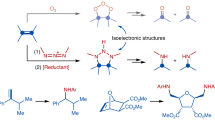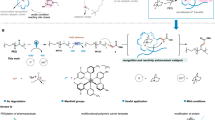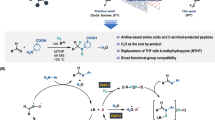Abstract
THE value of lithium aluminium hydride as a reagent for the characterization of the C-terminal residues of proteins has been investigated by several workers1; but, except in the case of insulin2, the potentialities of lithium borohydride have been less fully explored. Grassmann, Hörmann and Endres3 have described a method for the characterization of the C-terminal residues of small peptides which involved esterification followed by reduction with lithium borohydride hydrolysis and identification of the amino-alcohols produced. When a similar technique was applied to procollagen4, amino-alcohols were obtained even from the un-esterified protein and it was concluded that carboxylic ester groupings were present. Experiments carried out in this laboratory and described below show, however, that cleavage of peptide bonds can be brought about by lithium borohydride, those bonds involving the carboxyl group of glycine or of alanine being particularly susceptible. At present, therefore, little confidence can be placed in lithium borohydride as an end-group reagent for large peptides or proteins.
This is a preview of subscription content, access via your institution
Access options
Subscribe to this journal
Receive 51 print issues and online access
$199.00 per year
only $3.90 per issue
Buy this article
- Purchase on SpringerLink
- Instant access to full article PDF
Prices may be subject to local taxes which are calculated during checkout
Similar content being viewed by others
References
For a summary of recent work, see Fromageot, C., and Jutisz, M., “The Chemical Structure of Proteins”, 82 (J. and A. Churchill, Ltd., London, 1953).
Chibnall, A. C., and Rees, M. W., “The Chemical Structure of Proteins”, 70 (J. and A. Churchill, Ltd., London, 1953).
Grassmann, W., Hörmann, H., and Endres, H., Chem. Ber., 86, 1477 (1953).
Grassmann, W., Endres, H., and Steber, A., Z. Naturf., 9b, 513 (1954).
Elliott, D. F., Biochem. J., 50, 542 (1952); “The Chemical Structure of Proteins”, 129.
Grassmann, w., Hörmann, H., and Endres, H., Hoppe-Zeyl. Z., 296, 208 (1954).
Jutisz, M., Privat de Garilhe, M., Suquet, M., and Fromageot, C., Bull. Soc. Chim. Biol. Paris, 36, 117 (1954).
See, for example, Weygand, F., and Tietjen, D., Chem. Ber., 84, 625 (1951). Wittig, G., and Hornberger, P., Liebigs Ann., 577, 11 (1952). Snyder, H. R., and Putnam, R. E., J. Amer. Chem. Soc., 76, 1893 (1954).
Author information
Authors and Affiliations
Rights and permissions
About this article
Cite this article
CRAWHALL, J., ELLIOTT, D. Fission of Peptide Bonds by Lithium Borohydride. Nature 175, 299–300 (1955). https://doi.org/10.1038/175299a0
Issue date:
DOI: https://doi.org/10.1038/175299a0



